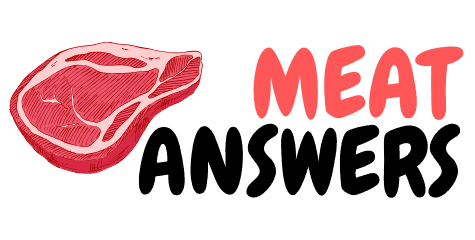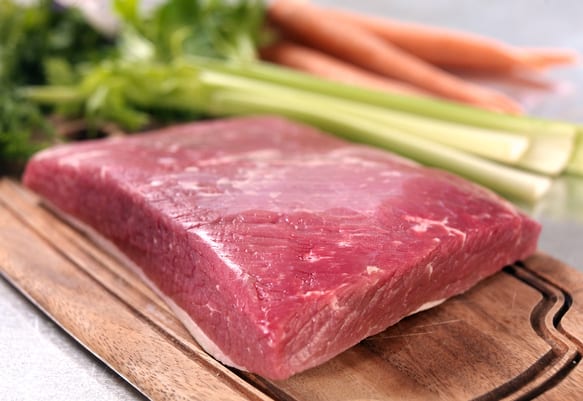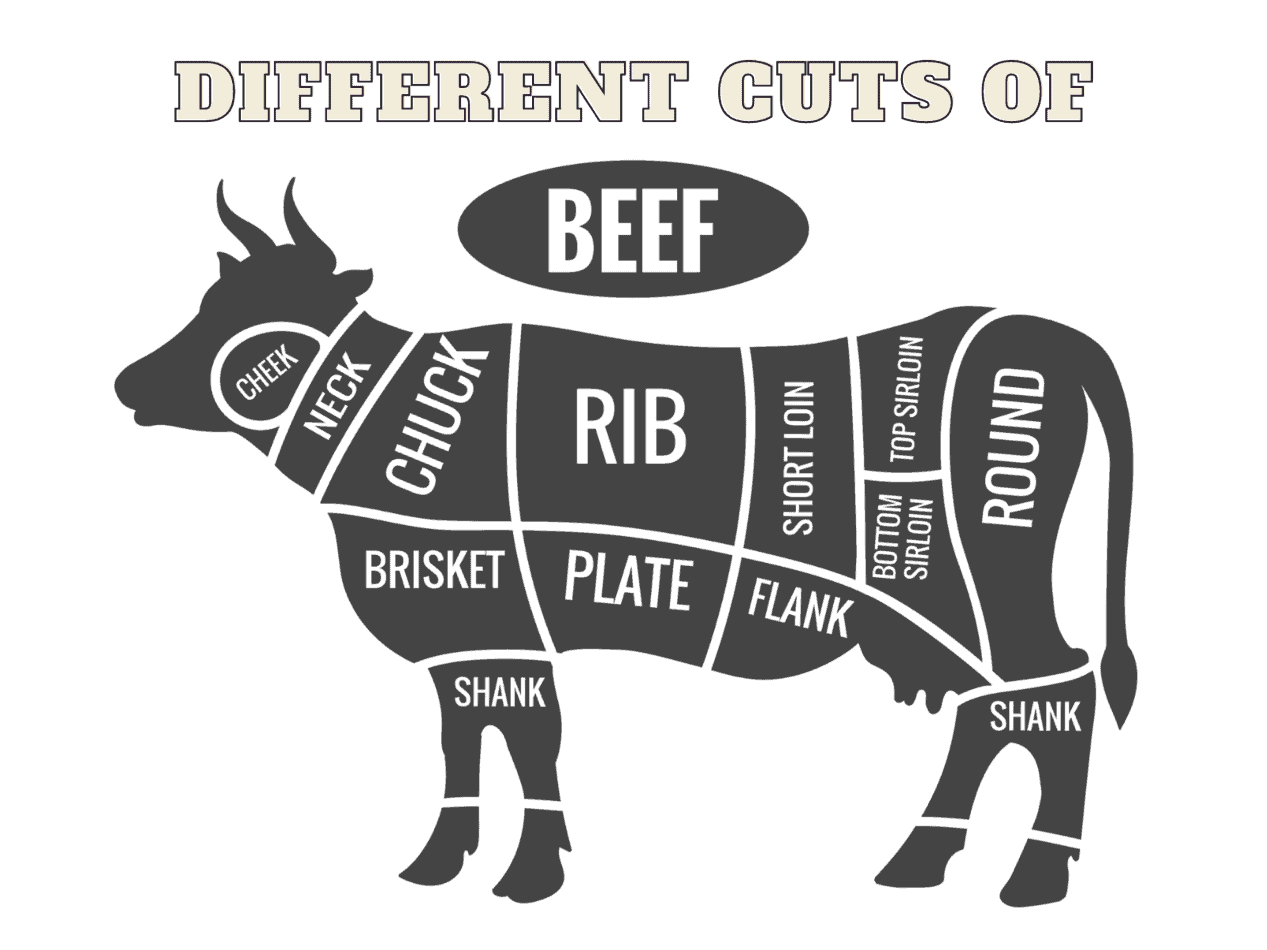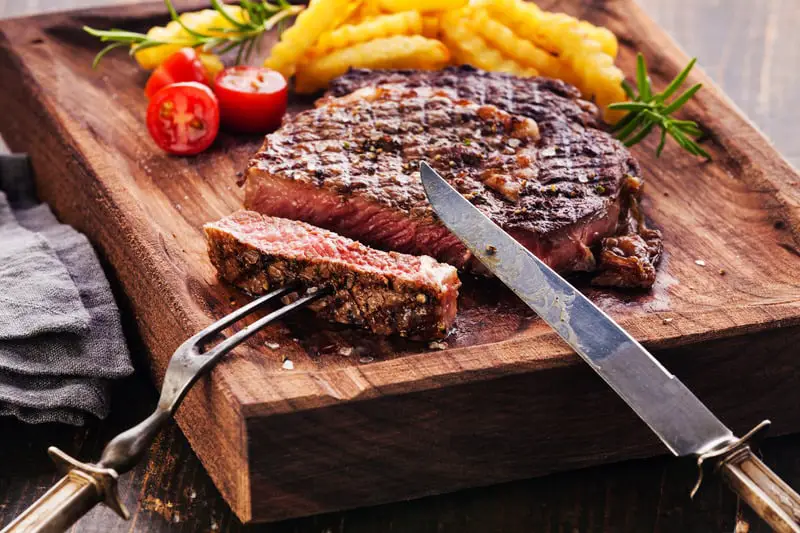You don’t need a separate cutting board for raw meat! All cutting boards are built equal, and you can cut any food items — vegetables, meats on the same board! Unfortunately, these statements are absolutely incorrect!
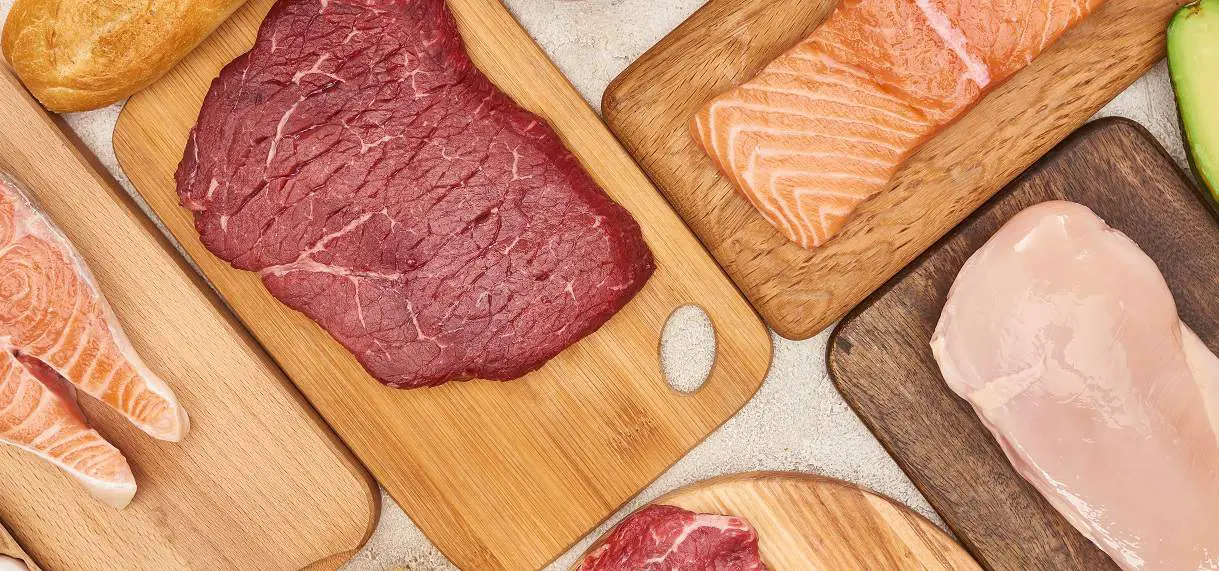
When it comes to preparing raw meat, there’s a lot of icky stuff to worry about. Apart from accidental injuries, safely handling raw food is a skill every novice and seasoned chef ought to master.
And it all starts with buying the best raw meat cutting board — the John Boos CB1054-1M2015150 Cutting Board.
Table of Contents
- 1 Why do We Need a Separate Cutting Board for Raw Meat?
- 2 When do You Go for a Cutting Board vs Carving Board vs Butcher Block?
- 3 What to Consider When Buying a Cutting Board for Meat?
- 4 Different Types of Meat Cutting Board Materials
- 5 What are the Choices for Best Cutting Board for Meat?
- 6 How to Clean a Cutting Board for Meat to avoid Cross contamination?
- 7 What is the difference between a cutting board and butcher block?
- 8 What is the most sanitary type of cutting board?
- 9 Is it safe to use a wood cutting board for meat?
- 10 Why should you not use a wooden cutting board for cutting raw meat?
- 11 What are color coded cooking boards?
Why do We Need a Separate Cutting Board for Raw Meat?
Safe handling of raw meat doesn’t stop at storing and cooking meat at the right temperature, but also preventing the chances of food poisoning and food contamination in your kitchen.
Fact is bacteria can thrive in the most unexpected places, resulting in cross-contamination across your surfaces.
And given that any kind of raw meat, be it serving up tantalizing mozzarella-stuffed chicken parm for lunch or crunchy, classic and healthy air fryer fish for dinner, the raw meat in the recipe can contain bacteria.
And when you don’t use a different cutting board for different cuts of meat or different types of meat such as meat, poultry or seafood, these bacteria can contaminate other food items chopped on the same board.
What’s even worse is that these bacteria are tough to kill, even if you wash your cutting board with hot soapy water, as they tend to accumulate in the cutting board’s crevices.
When do You Go for a Cutting Board vs Carving Board vs Butcher Block?
The words cutting board, carving board and butcher block are often used interchangeably, but they are indeed three different surfaces designed for different purposes.
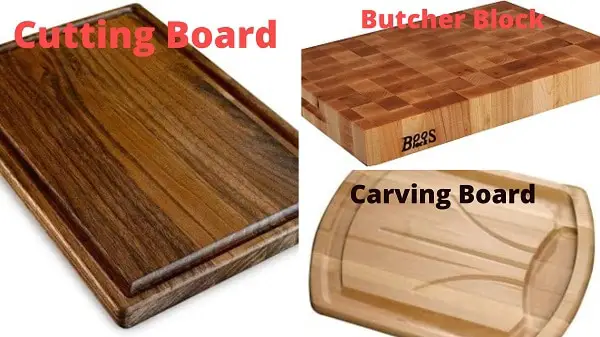
While you can use both cutting boards and carving boards for many of the same tasks, the former is typically used for chopping raw meat, and other food items.
Carving boards give you the best of both worlds — cutting and chopping raw meat, because you can use one side for each action. Carving boards however are a bit more versatile than chopping boards, because you can also use them for serving.
Further, carving boards feature a well running along their edges for collecting the juices stemming from the meat you’re cutting – whether cooked or raw meat.
And since even the best meat cutters can make a mess if placed directly on your kitchen countertop, you can place a cutting board underneath to collect the juices, and contain the splatter.
Butcher blocks are distinct from cutting boards and carving boards for several reasons, most notably their bigger size. Cutting boards and carving boards can handle light prep work such as slicing, dicing and chopping.
Butcher blocks are generally made using end grain, and measure approximately one and a half inches thick. Therefore. they can handle heavy duty tasks such as quartering, deboning, chopping and filleting or those that require a larger working surface.
What to Consider When Buying a Cutting Board for Meat?
Even though cutting boards may seem like a basic food prep tool, there are lots to consider when choosing for the best one for your needs.
You should ideally have two cutting boards in your kitchen — one to cut fish, meat and poultry, and another for everything else.
You can also have a third one — a carving board, if you’re going to cut meat after it’s finished cooking and resting, just before serving.
How frequently and what you will cut?
Regardless of what meat you will be cutting, you should buy a cutting board that’s sturdy, and rests flat on your kitchen counter. Further, it should also be easy to clean, and not retain odor or warp over time.
Cutting boards can be made from myriad different materials, but wood and plastic cutting boards are highly recommended for cutting raw meat.
Some food experts suggest that plastic cutting boards are safer than wood cutting boards, but this may not always be true. People assume that plastic cutting boards are more resistant to bacteria, since wood is a porous surface.
But in fact, research indicates that salmonella bacteria do indeed sink down to the bottom of wood cutting boards, but on a brighter note does eventually die off.
This trait of wood cutting boards make them a great choice for meats susceptible to salmonella bacteria such as beef, chicken and pork.
With plastic boards however, it depends on how old the board is, where boards right out of the box are easier to clean and disinfect, and weathered plastic boards will probably hold on to the bacteria, owing to the hard-to-clean grooves.
Another common question consumers ask is can you cut frozen meat with a meat slicer or should you use a cutting board? Answer is you can cut meat frozen meat with a cutting board as long as you have a sturdy steel knife or electric knife.
But this will require a fair bit of effort even when using a good-quality super sharp knife, and in worse cases you may end up damaging the board, especially if it’s made of wood, and you use it frequently.
Size and weight cutting board matters, and here’s why!
The bigger the size, the larger space you have to work with on your cutting board. Large size cutting boards are especially great if you’re cutting for big-size juicy steaks or savory fish fillets.
But bigger is not always better, because larger raw meat cuttings boards are generally heavier and bulky, making them a bit challenging to lift, wash and store.
In terms of thickness, cutting boards that are too thick may be uncomfortable to use, but you also want to buy a board that offers the right level of elevation.
It is also a good idea to measure the size of your counter where you’re going to place the cutting board, as you don’t want to buy one that partially hangs over the edge, as this could be extremely unsafe.
Features of cutting boards
Grooved or flat – one of the key features of cutting boards is whether it’s completely flat all around or whether it has a groove around the edges.
If you’re going to be cutting juicy meats, and want to prevent the mess of liquid spilling all over your counter or want to collect the juices from cooked meats, then buying a cutting board with grooves makes sense for collecting the juices.
But grooved cutting boards also mean less chopping space, which is something you may want to consider if you have less counter space or you have a lot of meat to cut.
Design – apart from the grooved or flat edge, there are several different features to consider such as the design of the respective board.
Some raw meat chopping boards feature a reversible design, which allows you chop on both sides, and prevent cross-contamination.
Then you’ve got cutting boards that are fitted with non-slip grips on the edges of the bottom, which secure your board on your counter during use.
Newer model cutting boards feature indentation in the corners or come with a holder to prop up your smartphones to watch videos on cutting frozen meat, cutting against the grain of meat or how to cut chicken breast against the grain while you prep.
If you’re going be chopping different types of meat at the same time, you may want to buy a cutting board that allows you to store and organize your meats while you cut such as the IFELES bamboo cutting board with grooves.
If you’re going to be using the cutting board in other areas apart your kitchen counter such as your coffee table, consider buying a chopping board that comes with foldable feet, and anti-warp bars to prevent any damage to your coffee table or other furniture.
Different Types of Meat Cutting Board Materials
As mentioned earlier, cuttings boards can be ordered in a broad spectrum of different materials including superior quality wood such as maple, teak or beech.
Eastern hard rock maple wood is regarded as the gold standard, whereas western maple is considered a close competitor.
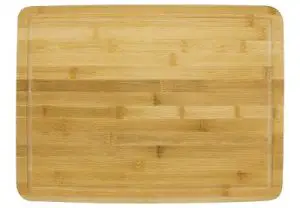
Bamboo – cutting boards crafted from bamboo are ECO friendly, making them a preferred choice over plastic cutting boards. Bamboo cuttings boards also offer great durability and longevity, and typically showcase hard dense, yet porous consistency.
This makes bamboo cutting boards a great choice for chopping meats and poultry. Owing to being harder than maple and oak, bamboo cutting boards resist knife scarring, and won’t dull your expensive knives.
However, bamboo cutting boards aren’t dishwasher safe, and may require oiling periodically, which can be done easily using some mineral oil.
End Grain – when selecting the best material wood cutting boards, you will come across three common types — face grain, edge grain and end grain.
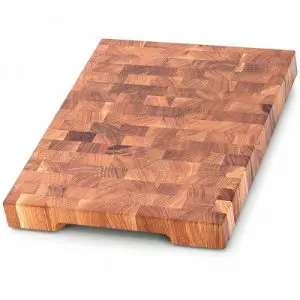
To explain the key differences between the three briefly, face grain cutting boards have one side that is wider than the other, where the wider side is referred to as the face.
Face grain wood cutting boards are highly appealing, but on the flipside may show knife marks faster than other grains.
With regards to edge grain vs. face grain cutting boards, they’re both almost the same, but end grain cuttings boards are much stronger and durable, and are less likely to crack or warp, owing to their solid block construction.
As the name would suggest, end grain boards are made from the end-pieces of wood that are stuck together, whereas edge grain boards are made from parallel pieces of wood and then glued together.
But unlike end grain cutting boards, edge grain cutting boards can develop cracks over time, caused by extensive use of knives, but are cheaper than end grain made chopping boards.
Plastic – even though plastic cuttings boards don’t boast the same elegant, sleek look as wood boards do, they are thinner, lighter and cheaper. Additionally, they’re easy to clean and store, and are easy to maintain, since you don’t have to sand or oil them before use.
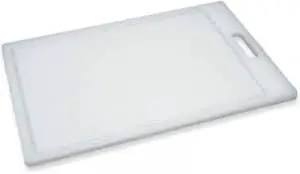
But plastic cooking boards do have a few downsides, starting with their lower resistance to scratches, stains and grooves.
Plastic cutting boards are usually made from two types of plastic — polyethylene (flexible and softer) or polypropylene (harder but more likely to shatter).
Wood – wood is billed as the best material for cutting boards, because it’s aesthetically pleasing, but also gentle on your knife’s blade, and more durable when properly cared for.
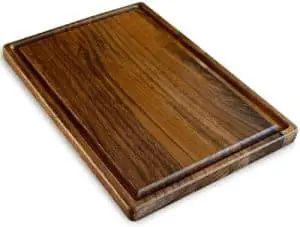
Wood cutting boards are made from several different types of hardwoods such as maple, mahogany, teak and cherry. Furthermore, wood cutting boards are also available in great designs, and features including handles, stripes and grips.
Glass – yes, glass cutting boards are also available, but it’s best to steer clear from these cutting boards. They are easy to clean, given their non-porous surface, but just imagine cutting meat and poultry over a glass cutting board!
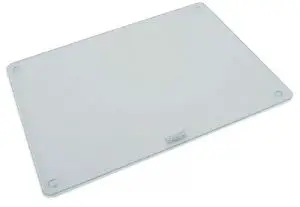
Glass cutting boards aren’t forgiving on your knife’s blade, and are prone to breaking and shattering.
Composite —for heavy duty use, composite cutting boards are truly hard to beat. They offer incredible durability and longevity, and are made from phenolic resins, and a combination of wood fibers.
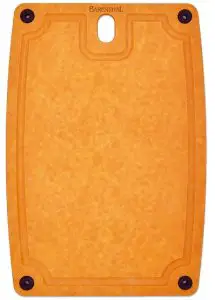
Composite cutting boards may not be as gentle on your knives as wood cutting boards, but they’re nearly impossible to stain, don’t require oiling, and best of all are dishwasher-safe.
What are the Choices for Best Cutting Board for Meat?
1. John Boos CB1054-1M2015150 Cutting Board
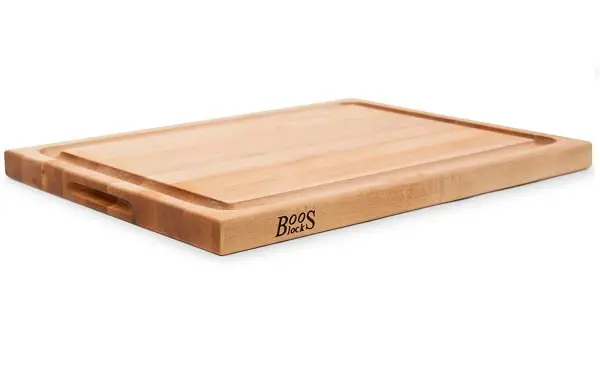
The John Boos cutting board slots in at the #1 position on this list of best cutting boards for raw meat for several good reasons, most notably the fact that it’s made in the USA, and from high quality and sustainably sourced, hand-selected solid Northern Hard Rock maple wood.
Adding to this, it can be had in a choice of four great colors and styles including cherry and maple with juice groove, and in two different sizes including 20 Inches x 15 Inches x 1.5 Inches.
Adding to its rich set of features is its reversible design, where one side is completely flat, whereas the other features a juice groove. Further, the John Boos raw meat cutting board features a desired 1.5-inch thickness, and is fitted with handgrips to easily list and move the cutting board.
The wood used in the John Boos cutting board features excellent antimicrobial properties, and contains naturally occurring enzymes that kill bacteria, which is yet another reason it is a good choice for cutting raw meat.
Even though you don’t have to, the company recommends application of Boos oil and cream with the John Boos applicator for an additional barrier against bacterial fluids. It comes with a 1-year warranty against any manufacturer defects.
Pros:
- Made in the USA
- Reversable design
- 5-inches thick
- Kills bacteria
- Made from sustainably sourced, hand-selected solid Northern Hard Rock maple wood
- 1-year manufacturer warranty
Cons:
- May be a little heavy for some users
2. Joseph Joseph 60002 Cut & Carve Multi-Function Cutting Board
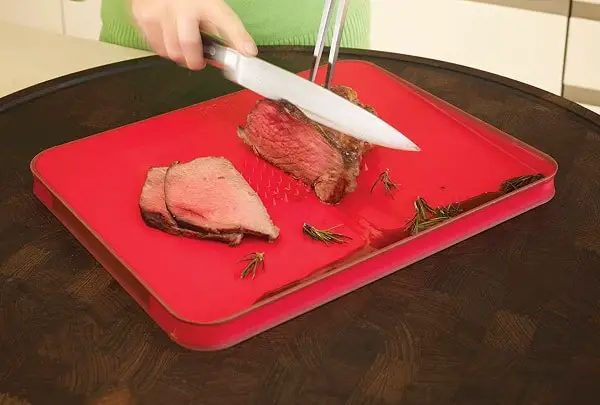
The Joseph Joseph ram meat cutting board can be had in a choice of four exciting colors including black, green and red, and features a reversible design, where one side features a meat grip.
It is made from high quality plastic, and showcases an angled cutting surface, which allows the juices to drain and collect when chopping or carving meat.
The Joseph Joseph raw meat cutting board measures 14-1/2 by 11-1/2 by 0-3/4-Inches, and tips the scales at just 12 ounces, making it a joy to work with and store.
The Cut & Carve Plus chopping board by Joseph Joseph is fitted with non-slip feet, so it will rest sturdily on your kitchen counter. Additionally, it has an approximately four cup juice holding capacity, features soft grip sides, and is dishwasher safe.
Pros:
- Double sided reversible design
- Made from high quality plastic
- Four colors available
- Measures 14-1/2 by 11-1/2 by 0-3/4-Inches and weighs 12 ounces
- Dishwasher safe
Cons:
- Meat grabbing teeth may not hold onto some meats well
3. Epicurean Kitchen Series Cutting Board
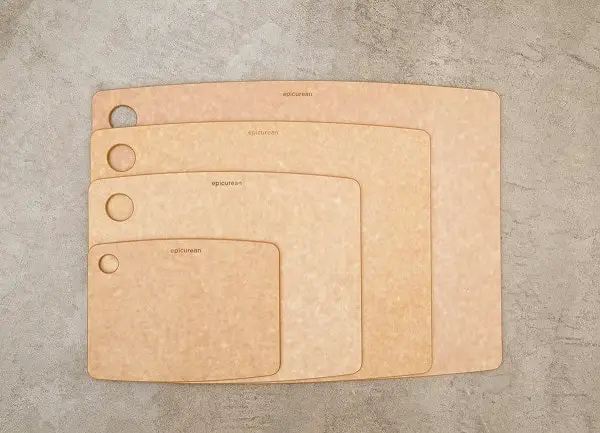
Made in the USA, the Epicurean Kitchen Series cutting board is in a league of its own with its Richlite paper composite material construction, and lightweight and sleek footprint.
The construction materials used in its construction are environmentally friendly such as recycled paper and plastic.
It measures 14. 5-Inch x 11. 25-inches, which is enough to chop large chunks of meat, and is NSF certified, so you can use it at home as well as in commercial kitchens.
The Epicurean Kitchen Series cutting board is available in three colors — natural, nutmeg and slate, and features a reversible surface, so you can use it on both sides.
It is embedded with a thumb hole for easy storage, and boasts a maintenance free design, so it doesn’t absorb or retain odors or harbor bacteria.
Best of all, the Epicurean Kitchen Series cutting board can resist heat up to a whopping 350 degrees, so you can also use it as a trivet. Furthermore, it’s dishwasher safe, knife friendly, and is often regarded as the best cutting board for Japanese knives.
Pros:
- Measures 14. 5-Inch x 11. 25-inches
- Richlite paper composite material construction
- NSF certified and three colors available
- Temperature resistant to 350°F
- Not absorb odors or harbor bacteria
Cons:
- Doesn’t come with cutting board oil
4. ROYAL CRAFT WOOD Organic Bamboo Cutting Board with Juice Groove
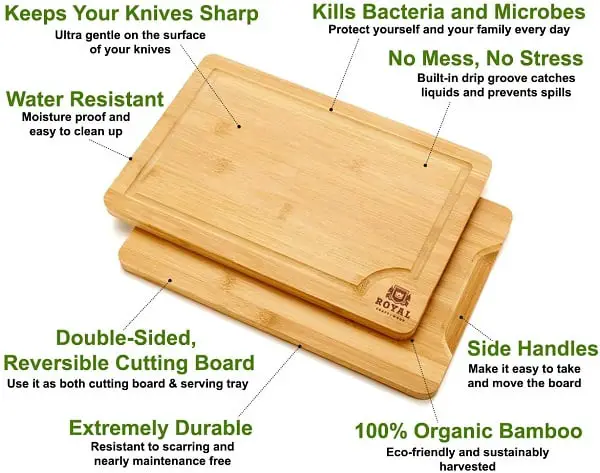
The ROYAL CRAFT WOOD cutting board is made from premium edge grain wood, making resistant to cuts and scarring. Further, it contains a larger density of fibers, which makes it self-healing over time.
It measures 18”x12”x0.75” inches, and is a great choice for chopping several food items. The ROYAL CRAFT WOOD cutting board features BPA free bamboo, which naturally resists bacteria penetration and growth.
The ROYAL CRAFT WOOD raw meat chopping board is knife-friendly, so it won’t dull your knives, and will look brand new for years. Adding to this, it features a reversible surface, and is equipped with side handles to easily move it across places.
It features a deep drip groove to catch all the juices, and can also be used as a serving tray for chicken, steaks and even cheese. To top things off, the ROYAL CRAFT WOOD cutting board is backed by a five-year manufacturer warranty against any defects.
Pros:
- Reversible design
- Measures 18”x12”x0.75” inches
- Made from premium edge grain wood
- Self-healing design and features BPA free bamboo
- Integrated deep drip groove
- Side handles and 5-year manufacturer warranty
Cons:
- Limited to 1 color option
5. HHXRISE Organic Bamboo Cutting Board
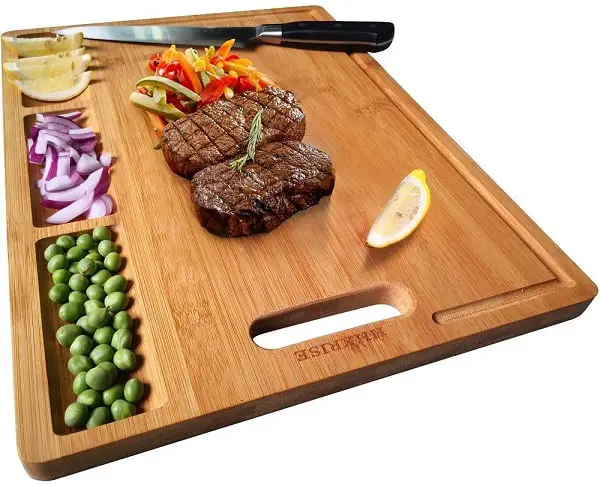
The HHXRISE organic cutting board as you might’ve guessed is made from BPA free organic bamboo, and is topped with a well-polished smooth surface.
Furthermore, it features an extra-large 17×12.6×0.72 inches cutting real estate, and is highly versatile in that it can be used as a chopping, carving, and cheese carving board.
This cutting board is especially a good choice for cutting raw meats, thanks to its onsite compartments and juice grooves. Speaking of which, it comes with three separated compartments on one side, so you can organize your foot items as you cut.
The HHXRISE raw meat cutting board measures 1.8 cms thick, and features a built-in handle to easily carry and take with you. Given its bamboo construction, the HHXRISE cutting board will not dull your knives and cutlery even after long periods of use.
Pros:
- Made from BPA free organic bamboo with polished surface
- Extra-large 17×12.6×0.72 inches cutting area
- 3 separate compartments and juice grooves
- 8 cms thick
- Knife friendly
Cons:
- Not dishwasher-safe
How to Clean a Cutting Board for Meat to avoid Cross contamination?
Cleaning a cutting board may seem like a no-brainer, where you simply scrub it with dishwashing soap, and run it under water. But it’s in fact a tricky process, considering the process is a bit different for different materials.
How to clean wood cutting board?
There are several ways to clean a wood cutting board without damaging the surface. The easy way is to simply use some dish soap, brush or sponge and hot water.
Start by scrubbing the surface with preferably anti-bacterial dish soap, and be sure to put in extra effort into knife marks, scratches, or where you notice any inconsistencies in the wood.
Scrub both sides of the board even if you use one side, because meat juices can be soaked up by the wood, and drip to the other side. Finally, thoroughly rinse your wood cutting board under hot water to get rid of the soap and bacteria, and dry with a cloth or paper towel.
A. Cleaning wood cutting boards with lemon
You can give your wood cutting board an effective spa-like treatment by using a few kitchen ingredients such as salt, lemon and of course a little elbow grease. What you will need for this task is coarse salt, half a lemon, warm water, bench scraper, and sponge or cloth.
Start by sprinkling the cutting board generously with salt, and rub the lemon while squeezing it across the cutting board.
Next, let the cutting board rest for roughly 15 minutes, and then grab a bowl, and scrape the gray, dirty liquid into it. You can now rinse the cutting board with warm water to make it squeaky clean.
B. Cleaning wood cutting boards with bleach
If you use your cutting board frequently to cut raw meat, then you should ideally add some bleach into the mix to ensure that you get rid of all the bacteria. Grab a gallon of water or so, add some bleach, let the cutting board soak in the bucket for 15 minutes, and then rinse and dry it off.
C. Cleaning wood cutting boards with vinegar
You can even use vinegar to clean your cutting board. It’s a chemical free process for cleaning your cutting board, and entails mixing one-part white vinegar to four parts water, soaking your cutting board in the mix for 15 minutes, and rinsing off and drying.
How to clean bamboo cutting board?
Cleaning bamboo cutting boards is a bit challenging, as they’re more vulnerable to warping and separating along glue lines. This type of board should be seasoned before use with a cutting board oil or wax, so that it can repel water, and prevent it from being absorbed by the board.
With a clean cloth, rub the oil or wax across the entire cutting board surface, and let it rest for at least 24 hours. To wash the board, scrub it with hot soapy water in the sink if it fits, and wipe it down with a dry cloth or paper towel.
How to clean end grain, glass and composite cutting board?
End grain, composite and glass cutting boards can be cleaned in the exact same way, where you scrub them with dishwashing soap, run them under water, and then wipe them dry. You can even run them through the dishwasher if they’re dishwasher-safe.
What is the difference between a cutting board and butcher block?
Ans: Cutting boards and butcher blocks may look considerably similar, and perform pretty much the same tasks, but are distinct from each by their roles in the kitchen.
Butcher blocks are heavier than cuttings boards, are made from end grain, and are at least 1.5 inches thick.
Cutting boards can be made from several different materials, and are available in a number of sizes. Therefore, they may not be able to handle heavy-duty taks such as cutting large chunks of raw meat.
What is the most sanitary type of cutting board?
Plastic is regarded as the most sanitary cutting board, and can be easily cleaned in the dishwasher. Wood cutting boards are fairly sanitary as well, owing to the fact it is naturally anti-microbial material.
Just like plastic, wood cutting boards also develop crevices over time, but the crevices are deeper, so the bacteria will fall in and eventually die.
Is it safe to use a wood cutting board for meat?
Yes and no — it’s safe to use wood cutting boards for meat as long as you wash them properly each time after use. But you should refrain from using a wood cutting board for raw meat if it’s not treated with oil before first use.
Why should you not use a wooden cutting board for cutting raw meat?
There are several reasons why you may not want to use a wooden cutting board for raw meat, most notably the fact that raw meat does let out unruly juices that can be absorbed by the wood, which then attracts bacteria.
This bacterium tends to pass through the top layer of the wood, and settles inside, and are hard to get rid of once inside. However, you can use a wood board to cut raw meat, as long as you wash it properly each time after use, and with bleach or lemon with hot water.
What are color coded cooking boards?
Government food and safety departments recommend using different color cutting boards for cooked and raw foods. But how do you keep track of which one you’ve used for raw and cooked foods.
Color coded cutting boards arrive in bold and easily identifiable colors, making it easier to note which color you’ve used for raw and cooked meat.
The five colors included in the pack are red (raw meat), yellow (cooked meat), blue (raw fish), brown (vegetables), green (fruits and salads), and white (dairy and bakery).
The Joseph Joseph Folio color coded cutting boards measure a large 9. 5 x 13. 4 inches, feature a reversable design, and comes with four dishwasher safe cutting boards, and a storage case.
